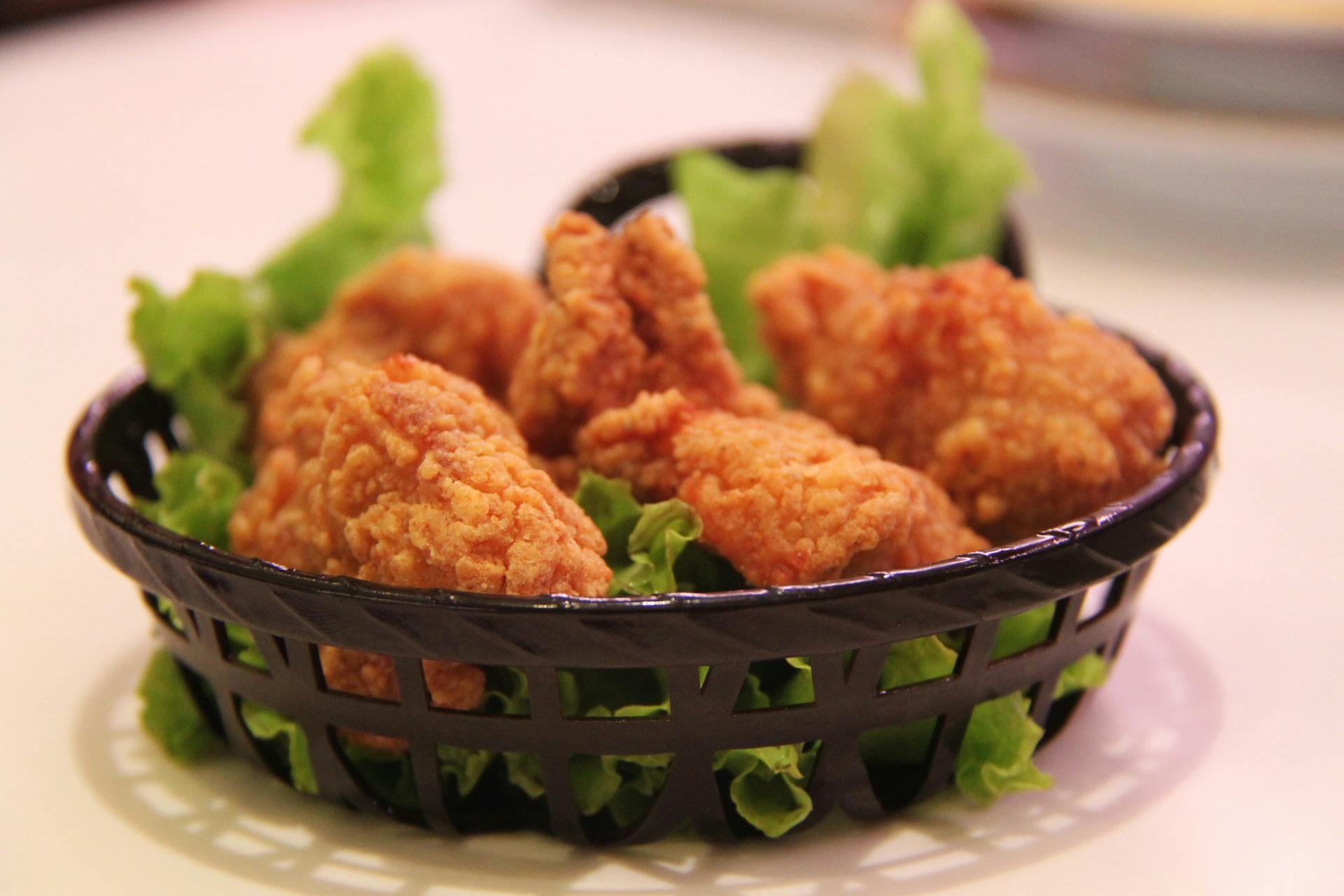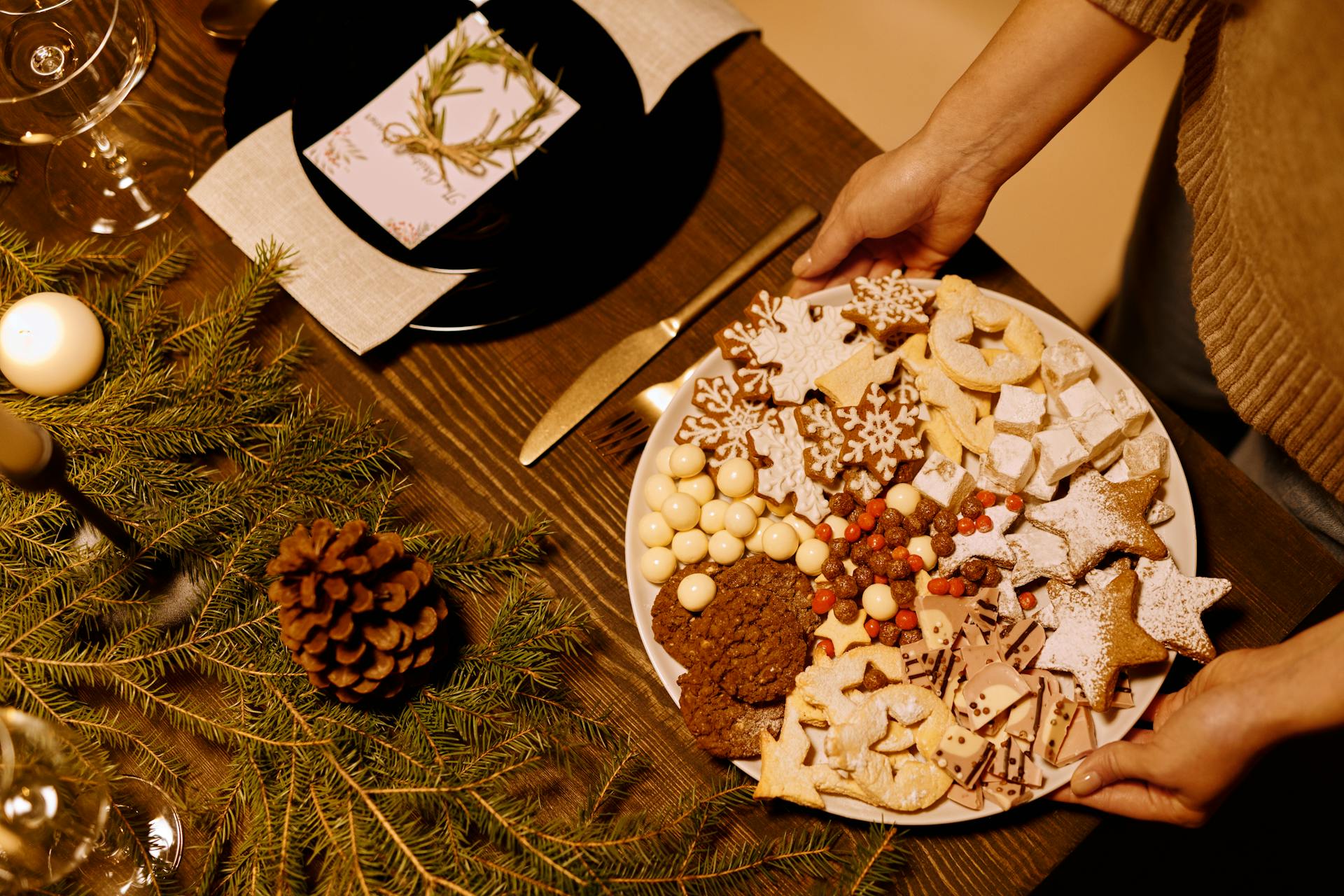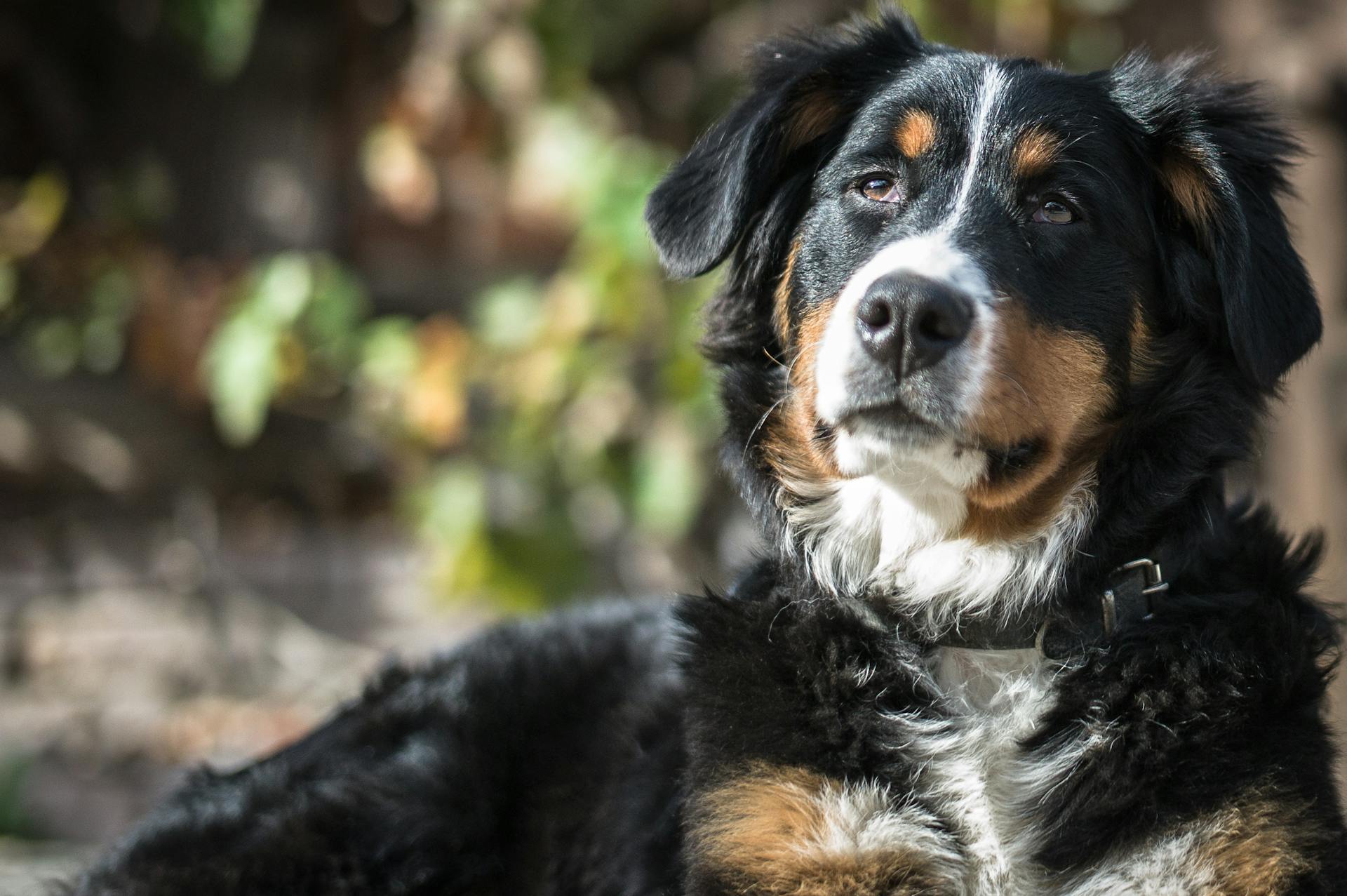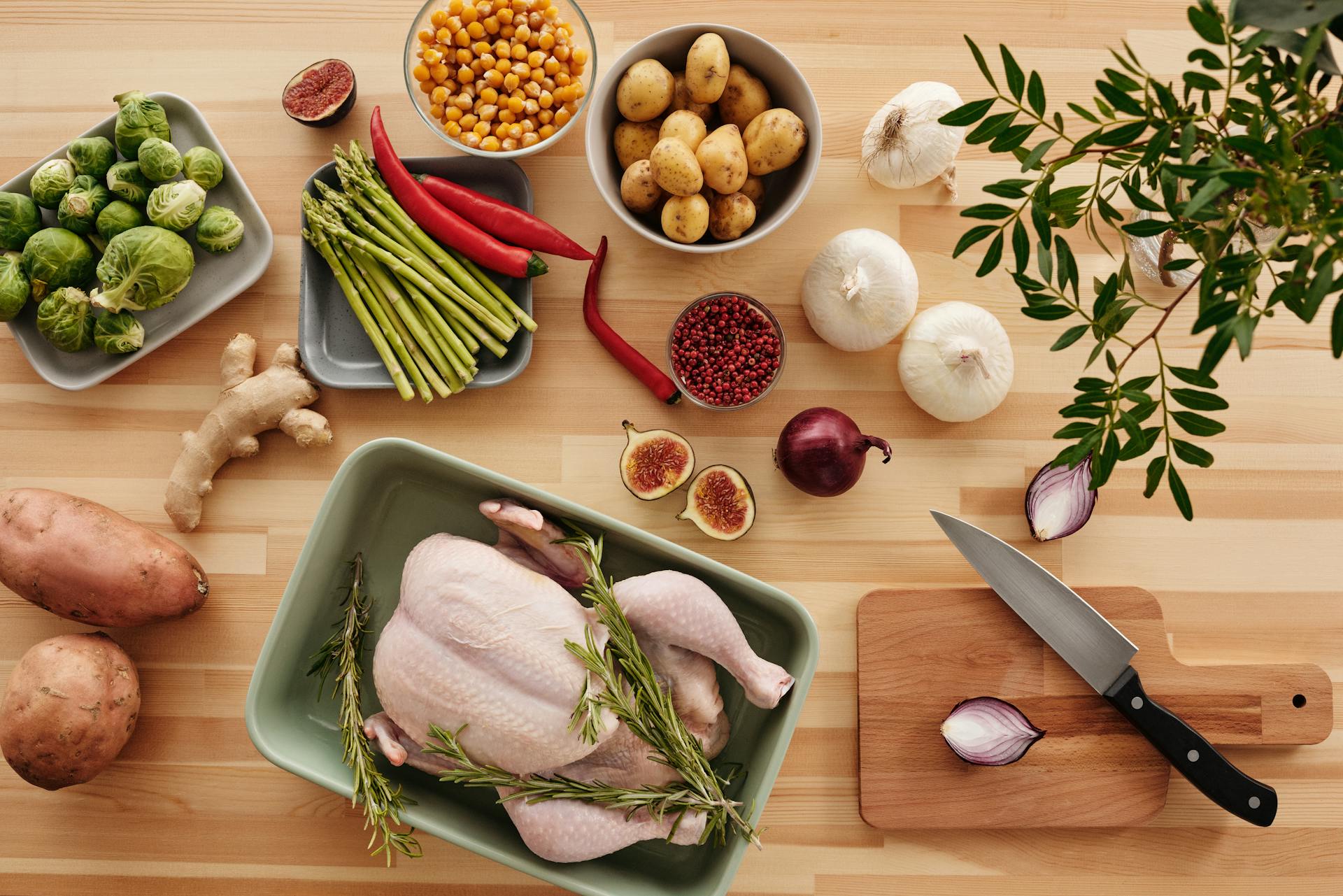
Chicken meat can be a nutritious addition to your dog's diet, but it's essential to choose the right type and amount.
Raw or undercooked chicken can pose a risk of bacterial contamination, such as Salmonella or Campylobacter.
Cooking chicken thoroughly can help kill these bacteria, but it's still crucial to handle and store it safely.
Dogs can benefit from chicken's high protein content, which can help support muscle growth and maintenance.
Benefits of Chicken Meat for Dogs
Chicken meat is a great choice for your furry friend. It's high in protein and low in fat, making it an ideal lean meat for dogs.
Chicken provides many essential nutrients, including vitamin B6, vitamin B3, and zinc, which help maintain your dog's overall health. These nutrients can help keep your dog's coat shiny, their energy levels up, and their immune system strong.
Cooked chicken breast is a great option for a bland diet, which can be soothing to your dog's stomach if prepared correctly. A typical bland diet includes boiled boneless skinless chicken breast with overcooked brown rice or mashed sweet potatoes.
Just remember to cook the chicken thoroughly to avoid the risk of salmonella and other foodborne illnesses. It's also essential to remove any bones, as they can cause choking or digestive issues.
If this caught your attention, see: Boil Chicken Breast
Cooking and Preparation
Chicken is a healthy food for dogs, but not all parts of the chicken are safe for them to eat.
To cook chicken for dogs, choose plain, boneless, and skinless chicken breasts or chicken thighs. These are the safest options for your furry friend.
You can cook chicken using various methods, but boiling is one of the quickest and easiest ways. To boil chicken, fill a medium size pot about ½ — ⅔ way with water and add your chicken breasts. They should be fully covered with water.
Boiling chicken takes less than half an hour, and since chicken is sold at almost every grocery store, it's an easy ingredient to get your hands on at the last minute. To ensure the chicken is cooked properly, set a timer for 12 minutes and check the pot occasionally to ensure the water is not either boiling over or getting too low.
A different take: Can Dogs Drink Pedialyte Water
After 12 minutes, check to see that the chicken is fully cooked by cutting open a piece of chicken. If it's fully cooked, it will be creamy white all the way through. Gelatinous or pink meat is a sign that it's still raw.
To avoid a potential choking hazard, cut the cooked chicken into small enough pieces depending on the size of your dog.
Here's a quick guide to boiling chicken for dogs:
Remember to always practice good hygiene when handling raw chicken to avoid food poisoning.
Feeding Guidelines
Feeding chicken to your dog can be a healthy and nutritious choice, but it's essential to do it in moderation.
Moderation is key when introducing chicken to your dog's diet. Start with small amounts and gradually increase the quantity based on your dog's size and weight.
A good rule of thumb is to feed your dog about 1/4–1/3 cup of meat protein per 20 pounds of body weight each day. You can use the following guide to determine the right amount of chicken for your dog:
How Much to Feed Your Pet
Feeding your pet the right amount of food is crucial for their health and happiness. Moderation is key when it comes to treats and occasional food toppers, like chicken.
When feeding your dog chicken, be sure it's thoroughly cooked and unseasoned. Chicken can be a great treat or occasional food topper for your pup.
For small dogs, a good rule of thumb is to start with 1-2 tablespoons of cooked, unseasoned chicken per day. This amount can vary depending on your dog's size and weight.
Here's a helpful guide to get you started:
Remember, every dog is different, and some may have sensitivities or allergies to chicken. If your dog experiences any digestive upset or discomfort after eating chicken, stop feeding it to them and consult with your veterinarian.
Feeding on a Bland Diet
A bland diet is used for a short period to alleviate gastrointestinal upset in dogs. This diet temporarily replaces a dog's regular food to calm down their stomach and allow it to heal.
The bland diet consists of a lean meat protein source, starchy carbohydrate, and a bit of fiber. It's essential to remove any raw food or treats from your dog's diet during this time.
Boiled chicken and rice are a common combination used in a bland diet, as they are easy to digest and can help soothe the stomach. This combination should be fed in a ratio of 1 part chicken to 2 parts rice.
It's crucial to remember that a bland diet is only meant for a short period, not as a long-term solution. If your dog's digestive issues persist, it's best to consult with a vet to rule out any underlying health problems.
Consider reading: Chicken and Rice Dog Treats
Nutrition and Safety
Chicken meat can be a nutritious addition to your dog's diet, providing protein, omega 6 fatty acids, and essential amino acids. It's also a low-fat meat that many dogs love.
To ensure your dog's safety, it's essential to handle raw chicken properly. You can feed your dog small pieces of chopped raw chicken breast as an addition to kibble or freeze-dried food, but be cautious not to overdo it and cause an upset stomach.
Chicken contains a small amount of Omega-3 fatty acids, which is crucial for maintaining your dog's skin and immune system health. A balanced diet with the right ratio of Omega-6 to Omega-3 fatty acids is key to avoiding skin issues and a weakened immune system.
A 100-gram serving of cooked boneless chicken breast provides 30g of protein, 111mg of Choline, and 10mcg of preformed Vitamin A as Retinol. This makes chicken a valuable source of essential nutrients for your dog.
A different take: Just Food for Dogs Omega plus
Nutrients in
Chicken is a nutrient-rich food that provides essential amino acids, vitamins, and minerals for dogs. A 100-gram serving of cooked boneless chicken breast contains 30g of protein, 111mg of Choline, 10mcg of preformed Vitamin A, and 5mg of calcium.
Chicken is also a good source of omega-6 fatty acids, which are necessary for a dog's healthy and balanced diet. However, a small amount of omega-3 fatty acids is also present in chicken.
A biological value of 79 out of 100 indicates that chicken has a high supply of essential amino acids that are digestible and highly nutritious.
Here's a breakdown of the nutrients found in a 100-gram serving of cooked boneless chicken breast:
Chicken contains several essential amino acids, including Arginine, Histidine, Isoleucine, Leucine, Lysine, Methionine, Phenylalanine, Threonine, Tryptophan, and Valine, which are vital for a dog's overall health.
By feeding your dog cooked chicken, you can provide them with a nutrient-rich food that supports their overall health and well-being.
Is Wet Food Good For?
Wet food can be a great option for dogs, especially for those who have trouble eating dry kibble.
Some wet dog foods are highly processed, which can be a concern for dog owners.
Wet dog food in a can typically has a higher moisture content than dry food, which can be beneficial for dogs who drink too little water.
The ingredients in wet dog food can be a mixed bag - some contain high-quality protein sources like chicken or salmon, while others may include fillers and by-products.
The pros of wet food include its ability to be highly palatable, which can make mealtime more enjoyable for dogs.
Explore further: 4 Health Wet Dog Food
Do Not Add Extra Fat or Oil
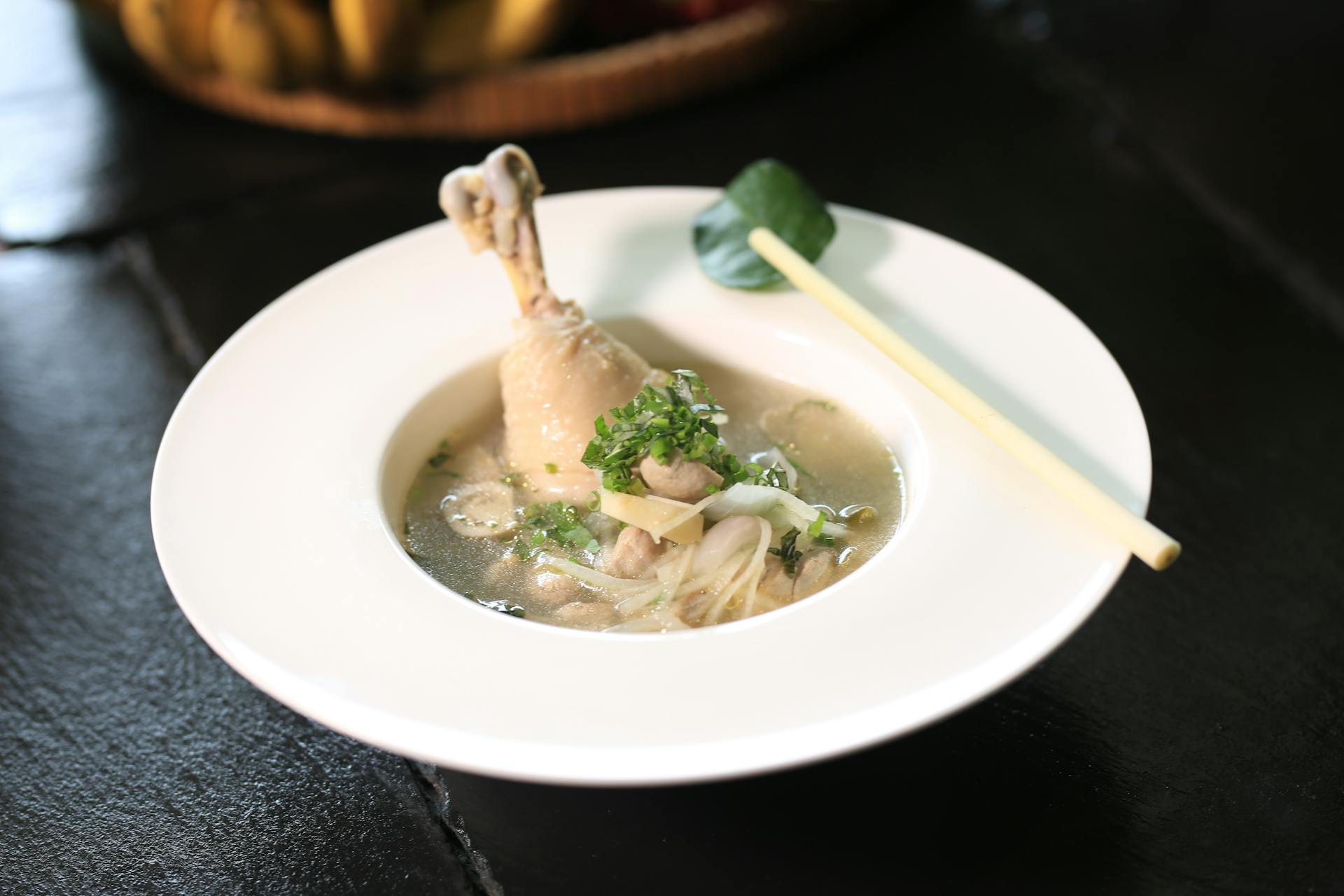
Don't add extra fat or oil to your dog's chicken meals, as it can cause digestive upset. This is especially true if your dog is prone to pancreatitis or diabetes.
The skin on chicken adds extra fat and oils that can be problematic. Stick to boneless skinless chicken breast for a healthier option.
Boiled, oven-baked, or pan-simmered chicken breast, dark meat, or ground chicken are all good choices. You can also use these methods to prepare chicken for your dog's kibble or freeze-dried dog food.
Freeze-dried dog food is a great way to provide your dog with a nutrient-rich meal. Dehydrating small pieces of chicken is also a good idea for making dog treats.
Remember, boiled chicken alone is not a nutritionally complete diet for dogs. It's essential to supplement with other ingredients to ensure your pup gets everything they need.
Expand your knowledge: Homemade Low Fat Dog Treats
Choosing the Right Chicken Meat
Chicken is an ideal lean meat for your dog, high in protein and low in fat, making it perfect for a bland diet.
You can boil boneless skinless chicken breast with overcooked brown rice or mashed sweet potatoes for a soothing meal. Avoid feeding large amounts of bland diet right away, and work to transition your dog back to a regular diet safely.
The best cut of meat for dogs is lean and has minimal fat, with options like chicken breasts, lean cuts of beef, and pork tenderloin being good choices. These cuts can be boiled, baked, or grilled, but avoid adding seasonings that might be harmful to your dog.
It's essential to source the chicken from a reputable source to avoid bacteria and poorly raised chickens, opting for pasture-raised or organic chicken whenever possible.
The Source of
The source of chicken is crucial when choosing the right meat for your dog. Sourcing from a reputable source is vital to avoid bacteria and poorly raised chickens.
Dogs can be prone to inflammation issues from consuming corn or grains fed to chickens. This is especially true for pasture-raised or organic chicken, which is less likely to cause inflammation problems.
Raw chicken necks and chicken wings can be a tasty treat for dogs, but they must be supervised at all times to avoid choking hazards.
A fresh viewpoint: Guard Dogs for Chickens
Best Cut of Meat
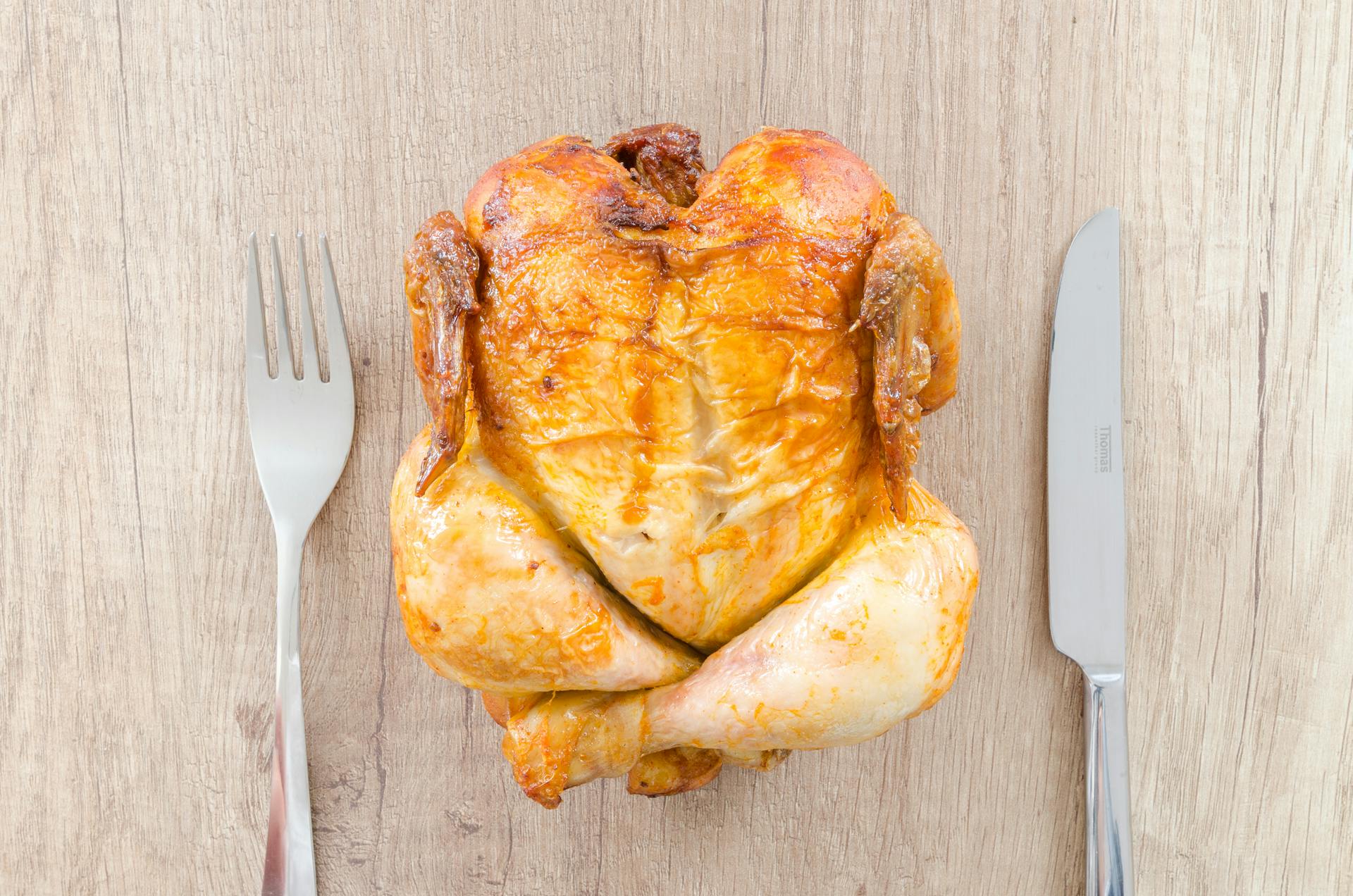
Chicken breast is a lean meat cut that's ideal for dogs due to its high protein content and low fat.
Chicken breast is a great option for a bland diet, as it can be soothing to the stomach when prepared correctly.
Lean cuts of beef, such as sirloin or flank steak, are also suitable for dogs, providing a balanced source of protein.
Pork tenderloin is another lean meat cut that's perfect for dogs, offering a variety of nutrients.
Meat should not be the sole ingredient in your dog's diet, as they require a balanced diet that includes carbohydrates and healthy fats.
Recommended read: Balanced Raw Food Diet for Dogs
Frequently Asked Questions
Is chicken an inflammatory food for dogs?
Yes, chicken can be an inflammatory food for dogs, as it may trigger pancreatitis in some canine companions. A balanced diet is essential to minimize the risk of this condition.
Is boiled chicken ok for dogs?
Yes, boiled chicken is a safe and healthy option for dogs, and it's often recommended by vets to help with digestive issues. However, consult with your vet before making any changes to your dog's diet.
Is too much chicken bad for a dog?
Consuming too much chicken can lead to nutritional imbalances and health issues in dogs. Moderation is crucial to ensure your dog's overall health and well-being
Sources
- https://www.petmd.com/dog/nutrition/can-dogs-eat-chicken
- https://www.raisedrightpets.com/blog/how-to-boil-chicken-for-dogs/
- https://nativepet.com/blogs/health/can-my-dog-eat-chicken
- https://www.justfoodfordogs.com/blog/healthy-meat-for-dogs.html
- https://rockykanaka.com/how-to-cook-boiled-chicken-for-your-dog-a-beginners-guide/
Featured Images: pexels.com
